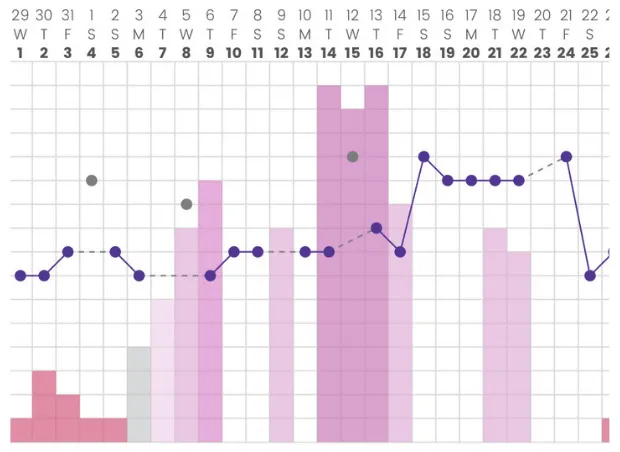Whether you are trying to conceive, looking for a natural contraception method or wanting general awareness of your reproductive health, tracking your monthly menstrual cycle is an informative tool to understanding your hormones.
The fertility awareness method (FAM) uses your basal body temperature and cervical fluid as data collected over the course of your cycle. Together these two markers can inform you of the transition from follicular to luteal phase, when you’re ovulating and if you’re pregnant. If you’re experiencing irregular cycles, fertility concerns or other hormonal irregularities, the FAM method can be a very informative tool in assessing cyclical patterns.
Understanding your monthly cycle is key to understanding and utilizing the FAM method. For a summary on your monthly hormonal cycle, click here.
Basal Body Temperature
What is it?
Your basal body temperature (BBT) is your resting temperature. BBT measurement allows you to predict when you’ve ovulated. This is important because if you’re trying to get pregnant, or avoid pregnancy, the first thing you want to know is if you are ovulating.
BBT is “bi-phasic”, which means there are two phases. During the follicular phase of your cycle, when estrogen is the dominant hormone present, your temperatures are relatively low. Once you’ve ovulated and entered the luteal phase, the corpeus luteum begins secreting progesterone. Progesterone is our “hot hormone”, it causes a rise in our temperature.
How to interpret BBT?
An increase in temperature of greater than 0.3 degrees celsius, indicates that progesterone is present and you’ve likely ovulated. When your temperature drops down again, this means your progesterone levels have dropped and your menses are likely on their way. Your cycle then resets.
Some key things to keep in mind:
• BBT measurements are not an indication of fertility, it informs you if you have ovulated. You need to use BBT in conjunction with cervical fluid to determine when you’re most fertile.
• BBT is a great method to assess the health of your luteal phase. A classic luteal phase is between 12-16 days. If your luteal phase is too short, or you’re not producing enough progesterone, this may cause problems when trying to conceive. This can be helpful information for your healthcare provider.
Your BBT should be taken at approximately the same time each day, before getting out of bed. If you get out of bed and move around, eat food, the temperature can increase and thus not be a true reflection of your resting temperature. There are several types of thermometers on the market, look for one with two decimal places (i.e. 36.67 degrees celsius), that reads for 1 minute. This ensures better accuracy. Tracking your information can be easily done through various apps. One I typically recommend is the free app, Kindara.
Place your thermometer beside your alarm clock or bedside table so when you wake up, make sure it is the first thing you do. Take your oral temperature as you lay in bed and slowly begin to wake up, and add your data to your app.
Cervical Fluid
What is it?
Detecting the subtle changes to your cervical fluid may take time as you become familiarized with your body. It can be extremely empowering to understand what is normal for your body, and allows you to take charge of your reproductive health when things aren’t functioning optimally.
Estrogen levels build during the follicular phase of our cycle. Some of the key things estrogen does during your cycle include:
• Supporting maturation of the follicle and egg.
• Promoting the growth of a healthy endometrial lining.
• Increased secretion of cervical fluid of more “fertile quality”.
How to interpret cervical fluid?
Typical cervical fluid changes go from: dry → sticky → creamy → egg white consistency.
What you want to focus on is the change in the consistency as the follicular phase progresses. Egg white quality indicates the most fertile phase. During peak fertility cervical fluid should resemble an egg white, clear, stretchy fluid. Some key things to keep in mind:
• There is no “normal” pattern of cervical fluid secretion – it depends on the person!
• Although egg white quality indicates the “most” fertile phase, there is still a chance of pregnancy with the presence of cervical fluid. Cervical fluid signs should be used in conjunction with BBT for best success.
To track cervical fluid, use a squarely folded piece of toilet paper, or your cleaned finger tips, to wipe across your vaginal opening front to back. Observe the colour, consistency and stretchiness. A classic egg white quality should be stretchy and not break apart.
Putting it all together.
Tracking your BBT and cervical fluid in concert, provides an informative look at the fluctuations of your hormones through the course of your cycle. Your cervical fluid indicates when you are most fertile, and your BBT indicates whether you have ovulated or not. If you’re trying to conceive, this informs when you should be timing intercourse. It’s best timed during your peak fertility, leading up to ovulation. Waiting until after you’ve ovulated is too late. If you’re using FAM to avoid pregnancy, you should be abstaining from intercourse or using secondary birth control methods (i.e. condoms), during your peak fertility phase.
Understanding your hormonal cycle is empowering and informative. It allows you to feel more confident when things aren’t working their best so you can have an open dialogue with your healthcare provider. The goal of this blog is to provide an overview of the FAM method and it’s by no means a comprehensive breakdown for each individual case. I highly recommend the book, Taking Charge of Your Fertility by Toni Weschler, for a deeper dive into the FAM method.
For more info, schedule a discovery call and we can review what’s going for you and how we can help.
In Health,
Dr. Ashley
Naturopathic Doctor – Vancouver, BC
Get started today
Dr. Ashley is accepting new patients, in-person and virtually across British Columbia.


